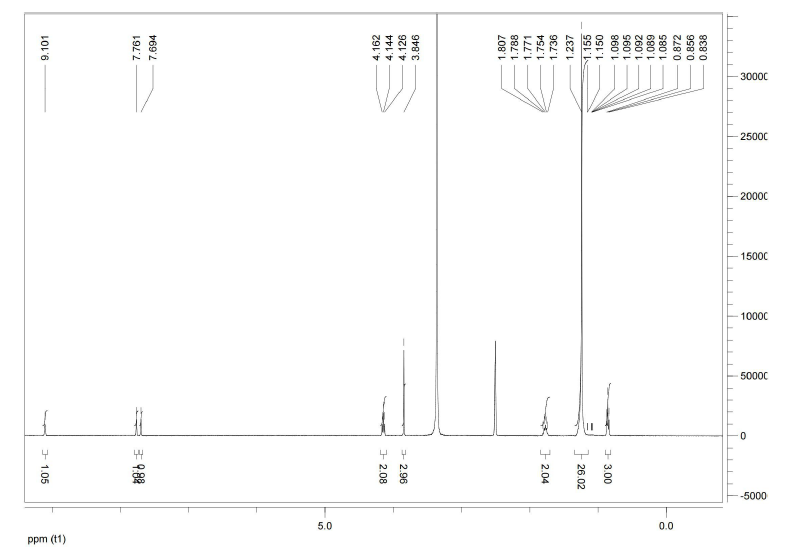1-hexadecyl-3-methylimidazolium bromide CAS#: 132361-22-9; ChemWhat Code: 500484
Identification
| Product Name | 1-hexadecyl-3-methylimidazolium bromide |
| IUPAC Name | 1-methyl-3-hexadecylimidazolium bromide |
| Molecular Structure |  |
| CAS Registry Number | 132361-22-9 |
| EINECS Number | No data available |
| MDL Number | MFCD19442853 |
| Beilstein Registry Number | No data available |
| Synonyms | 1-hexadecyl-3-methyl-3H-imidazol-1-ium; bromide1-hexadecyl-3-methylimidazolium bromide1-methyl-3-hexadecylimidazolium bromide |
| Molecular Formula | C20H39BrN2 |
| Molecular Weight | 387.441 |
| InChI | InChI=1S/C20H39N2.BrH/c1-3-4-5-6-7-8-9-10-11-12-13-14-15-16-17-22-19-18-21(2)20-22;/h18-20H,3-17H2,1-2H3;1H/q+1;/p-1 |
| InChI Key | QPERNWXRUSFVPU-UHFFFAOYSA-M |
| Canonical SMILES | CCCCCCCCCCCCCCCCn1cc[n+](c1)C.[Br-] |
| Patent Information | ||
| Patent ID | Title | Publication Date |
| CN114057615 | High-temperature-resistant polymerizable antibacterial agent, preparation thereof and application thereof in synthesis of antibacterial polyester | 2022 |
| US2015/45266 | IONIC LIQUID AS LUBRICATING OIL BASE STOCKS, COBASE STOCKS AND MULTIFUNCTIONAL FUNCTIONAL FLUIDS | 2015 |
Physical Data
| Appearance | Colorless Liquid |
| Solubility | No data available |
| Flash Point | No data available |
| Refractive index | No data available |
| Sensitivity | No data available |
| Melting Point, °C |
| 71 |
| 63 – 64 |
| 168 – 172 |
| 62 – 65 |
| 68 |
| Boiling Point, °C |
| 332 |
| Description (Association (MCS)) | Solvent (Association (MCS)) | Temperature (Association (MCS)), °C | Partner (Association (MCS)) |
| Association with compound | lithium hydroxide monohydrate | 24.84 | calix[6]arene-p-hexasulfonic acid |
Spectra
| Description (NMR Spectroscopy) | Nucleus (NMR Spectroscopy) | Solvents (NMR Spectroscopy) | Frequency (NMR Spectroscopy), MHz |
| Chemical shifts, Spectrum | 1H | chloroform-d1 | 400 |
| Chemical shifts, Spectrum | 13C | chloroform-d1 | 100 |
| Chemical shifts | 1H | chloroform-d1 | 400 |
| Chemical shifts | 13C | chloroform-d1 | 100 |
| Chemical shifts | 1H | water-d2 | 400 |
| Description (IR Spectroscopy) | Solvent (IR Spectroscopy) |
| Bands | potassium bromide |
| ATR (attenuated total reflectance), Bands | CCl4 |
| Description (Mass Spectrometry) |
| electrospray ionisation (ESI), spectrum |
| HRMS (High resolution mass spectrometry), Spectrum |
| Description (UV/VIS Spectroscopy) | Solvent (UV/VIS Spectroscopy) |
| Spectrum | lithium hydroxide monohydrate |
| pH dependence |
Route of Synthesis (ROS)
| Conditions | Yield |
| at 100℃; for 21h; | 100% |
| In toluene for 6h; Reflux; | 99% |
| In toluene for 6h; Reflux; Experimental Procedure 1-Hexadecyl-3-methyl imidazolium bromide synthesis: 1-methylimidazole(8.21 g, 0.100 mol) and 1-bromohexadecane (32.1 g,0.105 mol) were dissolved in 100 mL of toluene. The solution was put under vigorous stirring and refluxed for 6 h. The solvent was removed under reduced pressure and the solid was washed twice with ethyl acetate (200 mL each time) and dried under vacuum(Yield = 99%). | 99% |
Safety and Hazards
| GHS Hazard Statements | Not Classified |
Other Data
| Transportation | Under the room temperature and away from light |
| HS Code | No data available |
| Storage | Under the room temperature and away from light |
| Shelf Life | 1 year |
| Market Price | USD |
| Druglikeness | |
| Lipinski rules component | |
| Molecular Weight | 387.447 |
| logP | 10.252 |
| HBA | 1 |
| HBD | 0 |
| Matching Lipinski Rules | 3 |
| Veber rules component | |
| Polar Surface Area (PSA) | 8.81 |
| Rotatable Bond (RotB) | 15 |
| Matching Veber Rules | 1 |
| Use Pattern |
| 1-hexadecyl-3-methylimidazolium bromide CAS#: 132361-22-9 used as Ionic liquid. |
Buy Reagent | |
| No reagent supplier? | Send quick inquiry to ChemWhat |
| Want to be listed here as a reagent supplier? (Paid service) | Click here to contact ChemWhat |
Approved Manufacturers | |
| Ulcho Biochemical Ltd | http://www.ulcho.com/ |
| Want to be listed as an approved manufacturer (Requires approvement)? | Please download and fill out this form and send back to approved-manufacturers@chemwhat.com |
Other Suppliers | |
| Watson International Limited | Visit Watson Official Website |
Contact Us for Other Help | |
| Contact us for other information or services | Click here to contact ChemWhat |



